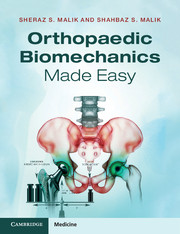Book contents
- Frontmatter
- Dedication
- Contents
- Contributors
- Epigraph
- Preface
- Acknowledgements
- Part I Orthopaedic biomaterials and their properties
- Part II Engineering theory applied to orthopaedics
- Part III Clinical biomechanics
- 6 Biomechanics of the hip and total hip replacement
- 7 Biomechanics of the knee and total knee replacement
- 8 Biomechanics of the shoulder
- 9 Biomechanics of the elbow
- 10 Biomechanics of the spine
- 11 Biomechanics of the ankle and foot
- 12 Biomechanics of fracture fixation
- 13 Trauma meeting: case-based discussions
- Index
9 - Biomechanics of the elbow
from Part III - Clinical biomechanics
Published online by Cambridge University Press: 05 June 2015
- Frontmatter
- Dedication
- Contents
- Contributors
- Epigraph
- Preface
- Acknowledgements
- Part I Orthopaedic biomaterials and their properties
- Part II Engineering theory applied to orthopaedics
- Part III Clinical biomechanics
- 6 Biomechanics of the hip and total hip replacement
- 7 Biomechanics of the knee and total knee replacement
- 8 Biomechanics of the shoulder
- 9 Biomechanics of the elbow
- 10 Biomechanics of the spine
- 11 Biomechanics of the ankle and foot
- 12 Biomechanics of fracture fixation
- 13 Trauma meeting: case-based discussions
- Index
Summary
Elbow: functional anatomy
The elbow increases the flexibility of the upper limb. It also transmits forces between the arm and the forearm and acts as the axis for the forearm lever system. The elbow is a complex of three joints of humerus, ulna and radius: humeroulnar, humeroradial and proximal radioulnar joints. All three joints are enclosed within the same capsule.
The distal humerus is divided into medial and lateral columns, which are tilted anteriorly approximately 40° from the humeral shaft. The columns form two articulating surfaces at the elbow joint: capitellum and trochlea.
The humeroulnar joint is a hinge joint formed by the hourglass-shaped trochlea articulating with the saddle-shaped trochlea notch of the ulna. This is an inherently stable configuration, and restricts undue relative motion between the articulating surfaces. The humeroradial joint is a ball and socket joint. It is an unconstrained joint formed between capitellum, which is an almost perfect hemisphere, and radial head, which has little contact with the capitellum. The proximal radioulnar joint is a pivot joint formed by articulation between the adjacent surfaces of the radius and ulna. It is a relatively constrained joint.
Range of motion
The elbow joint complex allows two types of motion: flexion and extension occur at the humeroulnar and humeroradial joints; and pronation and supination occur at the humeroradial and proximal radioulnar joints, and also require simultaneous motion at the distal radioulnar joint. The two types of motion are independent of each other. The normal range of flexion–extension is 0°–140°, and pronation–supination is 75° pronation – 85° supination. The functional range of flexion–extension is 30°–120°, and pronation–supination is 50° pronation – 50° supination.
- Type
- Chapter
- Information
- Orthopaedic Biomechanics Made Easy , pp. 136 - 141Publisher: Cambridge University PressPrint publication year: 2015



